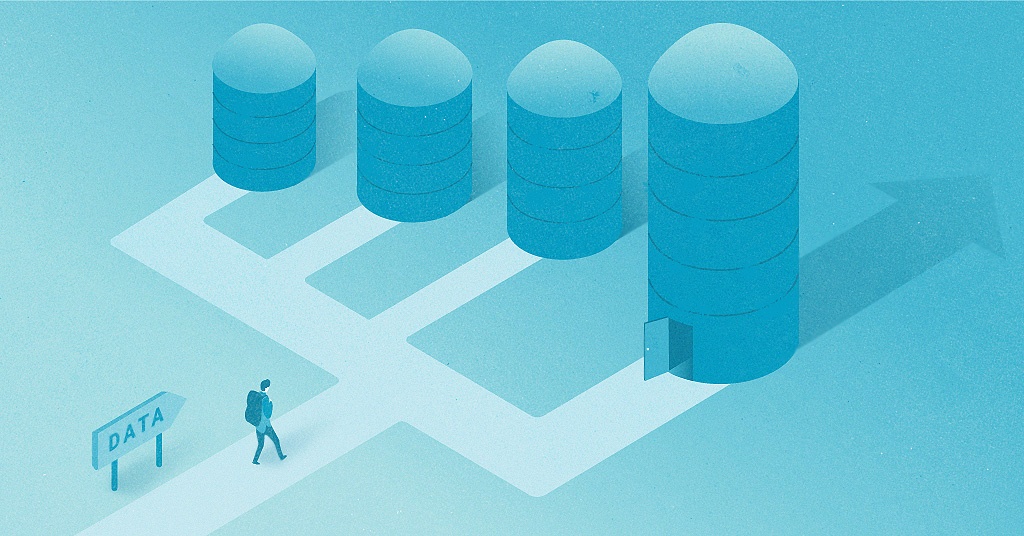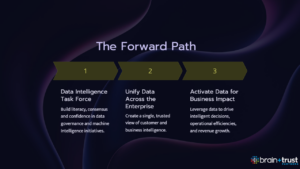In today’s hyper-connected business world, data is the currency of success. A company’s data powers its marketing, decision-making, and – soon – will power the AI models and digital twins that will enable it to effectively plan for, and secure, a future for its customers, employees, and shareholders. That’s a given – but despite that, many large organizations are still grappling with a common challenge: data fragmentation.
By splitting their customer data into business silos, companies prevent the seamless flow of information across departments, hindering targeted marketing efforts and personalized, exceptional customer experiences. Overcoming that data fragmentation, the act of data unification, can play a critical role in overcoming the internal friction created by data silos and help drive growth – whether that’s measured in deposits at a bank or ticket sales at your next live event.
And brain+trust is going to help you see how.
The Challenge of Breaking Down Silos

For CFOs, CMOs, and marketing executives, data fragmentation presents a significant hurdle in affordably acquiring and effectively retaining new customers. This is especially true for financial organizations, like credit unions, that rely on regional marketing rather than national name recognition to power their campaigns.
Traditionally, banks and credit unions have operated with several disparate, industry-specific software solutions to accomplish the many tasks related to their separate lines of business. These LOBs can have separate needs, which has historically lent itself to the creation of separate technology stacks and databases to accompany those separate needs. Member accounts, marketing campaigns, transaction histories, and more have different values and different requirements across LOBs, and this historically disjointed approach has made it challenging for many credit unions to get a comprehensive, 360-degree view of the member journey. This has limited the effectiveness of their marketing initiatives and member engagement strategies and held back member growth over time.
Consider a scenario where a potential member interacts with multiple touch points — a social media ad presented to “Jeff,” a branch visit by “Jeffrey,” and an online application “Louis J. Smith.” Without a master data management system in place to resolve those increasingly deprecated interactions into a single customer identity, the credit union may struggle to make the most of the opportunities presented by “Jeff” to tailor offers to his needs and provide that exceptional, personalized customer experience that will take him from casual customer to brand evangelist.
It’s obvious, then, that a fragmented approach to master data management not only impedes member acquisition but also hampers efforts to build lasting relationships with existing members.
Going Beyond Banking

The challenges presented by legacy data silos extend beyond banking, however. Businesses as different from banks as car dealerships and sports entertainment and live events promotions face similar hurdles in acquiring and engaging fans effectively. From ticket sales to merchandise purchases, fan engagement can span multiple channels and touch points, and without a unified view of fan data, organizations like NASCAR , Harley-Davidson, or the WWE will continue to struggle to deliver personalized experiences that can expand their core audiences and engage new generations of superfans.
By breaking down data silos and unifying fan data from various sources — ticketing systems, online platforms, merchandise sales, and more — companies that traditionally focus on a narrow demographic can gain deeper insights into fan preferences and behaviors within, and beyond their core customer base. These unified views can help enable novel marketing concepts, compelling promotions, and enhanced first-time fan experiences, ultimately driving repeat ticket sales, merchandise revenue, and product consumption both at-home or on-the-go in the form of mobile app and video engagements.
For both banking and sports promotions, the key to overcoming data silos lies in data unification. Integrating those disparate data sources into a centralized data platform and creating that single source of golden customer records that spans across departments and touch points.
In today’s data-driven business landscape, breaking down data silos is essential for driving a company’s digital transformation. Done right, data unification results in effective new customer acquisition efforts of all kinds — and by embracing data unification and leveraging technologies like Customer Data Platforms (CDPs) in their master data management plans, marketing executives can unlock the full potential of the first-party data they already have, and drive growth and engagement in their respective industries.
It’s time to break down the silos and harness the power of unified data for success as you continue down your path to AI readiness.
ORIGINAL CONTENT FROM BRAIN+TRUST







